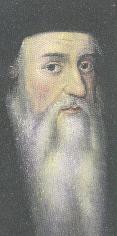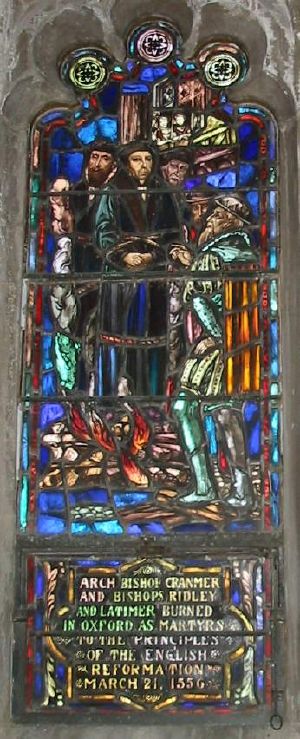Thomas Cranmer
Thomas Cranmer (July 2,1489 – March 21, 1556) was the Archbishop of Canterbury during the reigns of the English kings Henry VIII and Edward VI.
Born in 1489 at Nottingham, Cranmer was educated at Jesus College, Cambridge and became a priest following the death of his first wife. By the time of the controversy over the divorce of King Henry from his wife, Catherine of Aragon, Cranmer had risen to an influential position, and his willingness to pursue the matter on the King's behalf won him further advancement, despite the fact that he had secretly married the niece of a Lutheran theologian in Nuremberg. On March 30, 1533, he became Archbishop of Canterbury, and was able to push through the reforms that led gradually to the reform of the Church of England. In 1538 he condemned the views of John Lambert when he denied the real presence of Jesus Christ in the bread and wine of the eucharist. Lambert was burnt at the stake, but Cranmer later came to adopt his views. Cranmer also opposed Henry VIII's 6 Articles, which reaffirmed clerical celibacy.
On Henry's death in 1547, Cranmer became an indispensable advisor to his son and successor, Edward, who, though still a child, had been brought up with Protestant views. During Edward's reign, Cranmer introduced the Book of Common Prayer, a modernized version of which is still used today, and in general, led the Church of England in a more Protestant direction.
Edward died in 1553, to be succeeded by his half-sister, Mary I of England, who had been brought up a Catholic and wished to return the country to its former faith. Added to that she had personal reason to dislike Cranmer as, by annulling her parents marriage, he lead to her to being declared illegitimate. He had also, under pressure, signed in favor of proclaiming Lady Jane Grey Queen. He was removed from office, imprisoned and charged with both treason and heresy on February 14, 1556. In an effort to save himself, he recanted, but was nevertheless condemned to be burned at the stake. When he discovered his fate, he withdrew his recantation in church on the day of his death when he was expected by the authorities to re-affirm it. At the point of execution, he thrust his right hand into the fire, this being the hand which had signed the document. He was executed in Oxford where two other bishops, Ridley and Latimer, had been burned in 1555. The event is commemorated by the so-called Martyrs' Memorial, a Victorian construction not far from the original site, which is marked by a cross on the road.
| Preceded by: William Warham |
Archbishop of Canterbury | Followed by: Reginald Pole |
Further reading
- Diarmaid MacCulloch, Thomas Cranmer: A Life (1996)
External links
- [http://www.stpeter.org/cranmer.html Article on Cranmer
- BBC article
- Spartacus schoolnet
de:Thomas Cranmer fr:Thomas Cranmer nl:Thomas Cranmer no:Thomas Cranmer
Credits
New World Encyclopedia writers and editors rewrote and completed the Wikipedia article in accordance with New World Encyclopedia standards. This article abides by terms of the Creative Commons CC-by-sa 3.0 License (CC-by-sa), which may be used and disseminated with proper attribution. Credit is due under the terms of this license that can reference both the New World Encyclopedia contributors and the selfless volunteer contributors of the Wikimedia Foundation. To cite this article click here for a list of acceptable citing formats.The history of earlier contributions by wikipedians is accessible to researchers here:
The history of this article since it was imported to New World Encyclopedia:
Note: Some restrictions may apply to use of individual images which are separately licensed.

